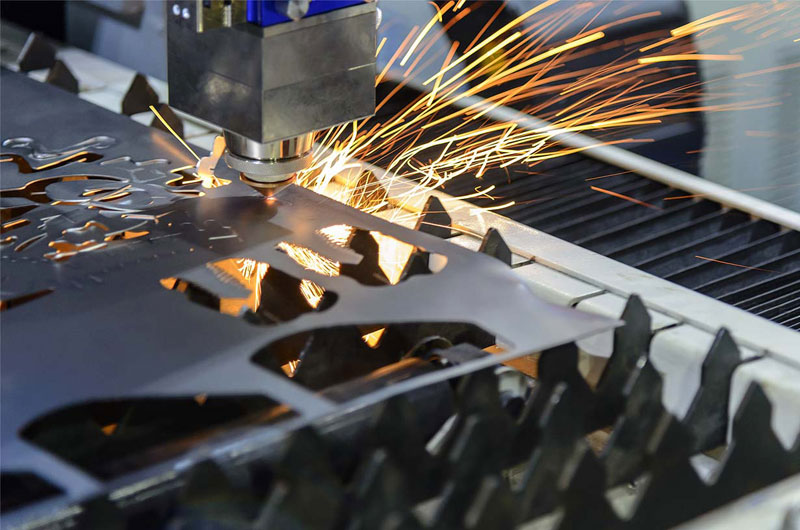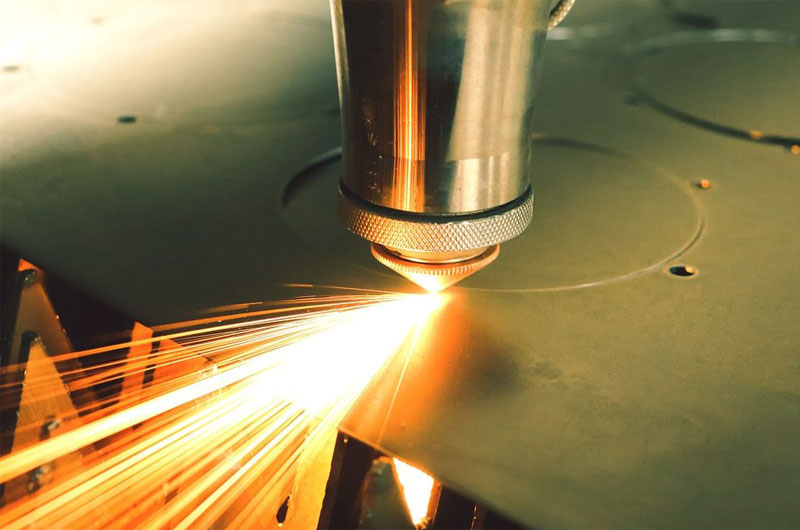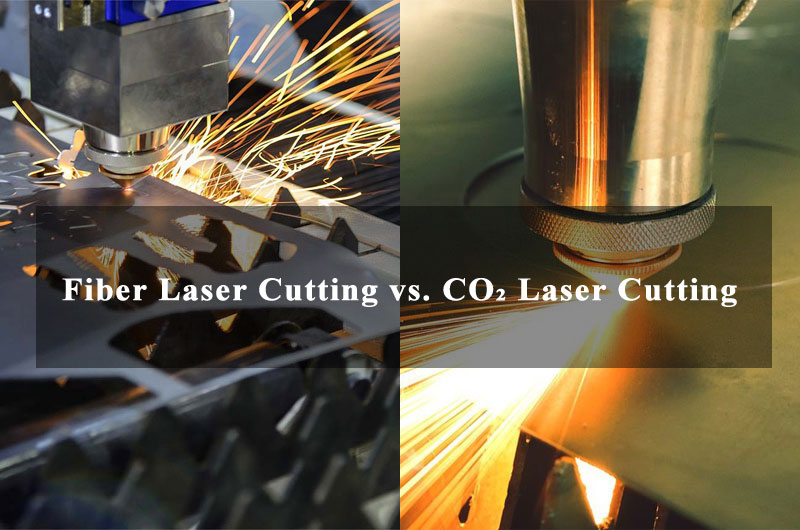Laser cutting has revolutionized modern manufacturing by offering precise, efficient, and versatile cutting solutions for metals, plastics, wood, and more. Among the most common laser technologies are fiber and CO₂ Laser cutting.
This article explores the differences between fiber and CO₂ laser cutting to help manufacturers choose the right technology for their application.
1. Understanding the Technologies
Fiber Laser Cutting

Fiber lasers represent a modern solid-state laser technology that generates light using a laser diode, which is transmitted through a fiber-optic cable infused with rare-earth elements like erbium or ytterbium. This produces a highly concentrated beam at a wavelength of 1.06 micrometers – 10 times shorter than that of a CO₂ laser.
The shorter wavelength allows for superior absorption by metals, making fiber lasers exceptionally efficient for metal cutting, particularly thin or reflective materials like aluminum, brass, and copper.
CO₂ Laser Cutting

CO₂ lasers are gas lasers that generate a laser beam by electrically exciting a gas mixture primarily composed of carbon dioxide, nitrogen, and helium. The light beam produced operates in the infrared spectrum at a wavelength of 10.6 micrometers, making it ideal for non-metallic materials such as wood, acrylic, plastics, glass, textiles, as well as thicker metals.
CO₂ lasers have been used in industrial cutting applications since the 1980s, and they are valued for their ability to produce smooth finishes on a wide range of materials.
2. Cutting Performance and Material Suitability
Fiber Lasers
Fiber lasers are excellent at cutting metals, especially reflective ones like aluminum, brass, and copper, which are difficult for CO₂ lasers due to their reflective properties at longer wavelengths.
- Thin to medium thickness metals: Highly efficient.
- Reflective metals: Safe and effective cutting without risk to the machine.
- Speed: They generally provide higher cutting speeds, particularly when working with materials up to 5 mm thick.
CO₂ Lasers
CO₂ lasers are versatile when it comes to cutting non-metallic materials, making them popular in industries like signage, textiles, and woodworking.
- Organic materials: Ideal for wood, leather, acrylics, paper, and fabric.
- Thicker metal sheets: Can cut thick carbon steel better than fiber lasers in certain cases due to smoother cut edges.
- Edge quality: Superior surface finish on thick materials.
3. Cutting Speed Comparison
Speed is a crucial factor in production environments. Fiber lasers generally outperform CO₂ lasers in cutting speed, especially on thin to medium metal sheets.
- Up to 5 mm thickness: Fiber lasers can be 2–3 times faster.
- Above 10 mm thickness: CO₂ lasers might offer better edge quality but are slower.
- Piercing time: Fiber lasers have faster piercing capabilities due to higher power density.
4. Operational Cost and Efficiency
Energy Efficiency
Fiber lasers are far more energy-efficient than CO₂ lasers.
- Fiber laser efficiency: ~30% wall-plug efficiency.
- CO₂ laser efficiency: ~10% wall-plug efficiency.
- Impact: Lower electricity bills and operational costs for fiber systems.
Maintenance
Fiber lasers require significantly less maintenance:
- Fiber lasers: No need for mirrors, laser gas refills, or alignment adjustments.
- CO₂ lasers: Require regular servicing, including mirror cleaning/replacement, gas tube maintenance, and beam alignment.
Overall, fiber lasers have lower lifetime ownership costs.
5. Beam Delivery and Focus
Beam Quality
Fiber lasers have a smaller focal diameter and better beam quality, resulting in:
- Higher precision cuts.
- Finer kerf width.
- Less heat-affected zone (HAZ).
This is advantageous for delicate or intricate parts, especially in industries like aerospace or electronics.
CO₂ Beam Characteristics
CO₂ lasers, due to their longer wavelength, have a larger focal diameter, leading to:
- Wider kerf.
- More heat dispersion, can impact the surrounding material.
- Smooth edges, especially on thicker non-metals.
6. Machine Footprint and System Complexity
Fiber laser systems are generally more compact and modular:
- Smaller power sources.
- No need for beam alignment optics.
- Can be integrated easily into robotic and automated systems.
CO₂ systems tend to be bulkier due to the optical path requirements (mirrors and tubes) and gas storage components.
7. Initial Investment
Equipment Cost
- CO₂ laser machines: Historically cheaper for entry-level models, especially for non-metal use.
- Fiber laser machines: Higher initial investment, but prices have decreased significantly over the years due to widespread adoption.
However, the lower operating and maintenance costs of fiber lasers often make them more economical in the long run.
8. Applications by Industry
| Industry | Fiber Laser | CO₂ Laser |
|---|---|---|
| Automotive | Cutting metal components | Interior trim, leather |
| Aerospace | High-precision metal parts | Composite materials |
| Electronics | Thin metals, PCB marking | Plastic casings |
| Signage | Stainless steel, aluminum letters | Acrylics, wood |
| Textile & Apparel | — | Fabric, leather, patterns |
| Construction | Metal fabrication | Insulation, plastic panels |
9. Safety Considerations
Fiber lasers emit at shorter wavelengths that are more hazardous to the eyes and often require fully enclosed systems with safety interlocks.
CO₂ lasers are less dangerous in that regard, but still require proper shielding, especially during cutting or engraving operations.
10. Pros and Cons Summary
Fiber Laser Pros:
- Fast cutting for thin/medium metals.
- Lower operating costs.
- Minimal maintenance.
- Compact and efficient.
- Better for reflective metals.
Fiber Laser Cons:
- Higher upfront cost.
- Limited performance on thicker materials.
- Not suitable for non-metals.
CO₂ Laser Pros:
- Cuts non-metallic materials very well.
- Better edge quality on thick metals.
- More affordable for basic applications.
CO₂ Laser Cons:
- High power consumption.
- Frequent maintenance.
- Poor performance with reflective metals.
- Slower cutting speeds on metals.
Conclusion
Both fiber laser and CO₂ laser cutting have their place in modern manufacturing. The best choice depends on the materials you work with, the production volume, budget, and desired precision.
- If you primarily cut metals, especially reflective ones, and want speed and low operating costs, a fiber laser is likely your best choice.
- If your focus is on non-metallic materials or you need a smoother edge finish for thicker parts, a CO₂ laser may serve better.
As laser technology continues to evolve, hybrid systems and application-specific innovations may further bridge the gap between the two, offering even more tailored cutting solutions for diverse industries.

